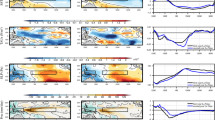Abstract.
The stability of the Atlantic thermohaline circulation against meltwater input is investigated in a coupled ocean-atmosphere general circulation model. The meltwater input to the Labrador Sea is increased linearly for 250 years to a maximum input of 0.625 Sv and then reduced again to 0 (both instantaneously and linearly decreasing over 250 years). The resulting freshening forces a shutdown of the formation of North Atlantic deepwater and a subsequent reversal of the thermohaline circulation of the Atlantic, filling the deep Atlantic with Antarctic bottom water. The change in the overturning pattern causes a drastic reduction of the Atlantic northward heat transport, resulting in a strong cooling with maximum amplitude over the northern North Atlantic and a southward shift of the sea-ice margin in the Atlantic. Due to the increased meridional temperature gradient, the intertropical convergence zone over the Atlantic is displaced southward and the westerlies in the Northern Hemisphere gain strength. We identify four main feedbacks affecting the stability of the thermohaline circulation: the change in the overturning circulation of the Atlantic leads to longer residence times of the surface water in high-northern latitudes, which allows them to accumulate more precipitation and runoff from the continents. As a consequence the stratification in the North Atlantic becomes more stable. This effect is further amplified by an enhanced northward atmospheric water vapour transport, which increases the freshwater input into the North Atlantic. The reduced northward oceanic heat transport leads to colder sea-surface temperatures and an intensification of the atmospheric cyclonic circulation over the Norwegian Sea. The associated Ekman transports cause increased upwelling and increased freshwater export with the East Greenland Current. Both the cooling and the wind-driven circulation changes largely compensate for the effects of the first two feedbacks. The wind-stress feedback destabilizes modes without deep water formation in the North Atlantic, but has been neglected in almost all studies so far. After the meltwater input stops, the North Atlantic deepwater formation resumed in all experiments and the meridional overturning returned within 200 years to a conveyor belt pattern. This happened although the formation of North Atlantic deep water was suppressed in one experiment for more than 300 years and the Atlantic overturning had settled into a circulation pattern with Antarctic bottom water as the only source of deep water. It is a clear indication that cooling and wind-stress feedback are more effective, at least in our model, than advection feedback and increased atmospheric water vapour transport. We conclude that the conveyor belt-type thermohaline circulation seems to be much more stable than hitherto assumed from experiments with simpler models.
Similar content being viewed by others
Author information
Authors and Affiliations
Additional information
Received 31 January 1996/Accepted 22 August 1996
Rights and permissions
About this article
Cite this article
Schiller, A., Mikolajewicz, U. & Voss, R. The stability of the North Atlantic thermohaline circulation in a coupled ocean-atmosphere general circulation model. Climate Dynamics 13, 325–347 (1997). https://doi.org/10.1007/s003820050169
Issue Date:
DOI: https://doi.org/10.1007/s003820050169




